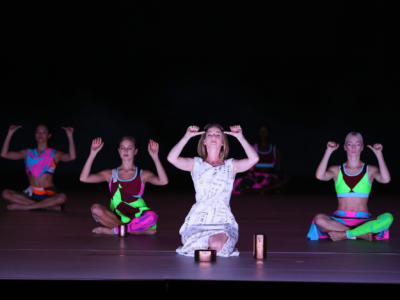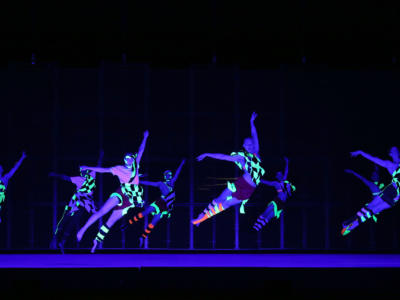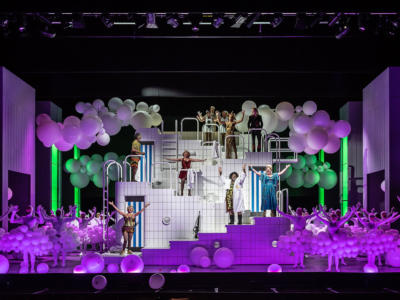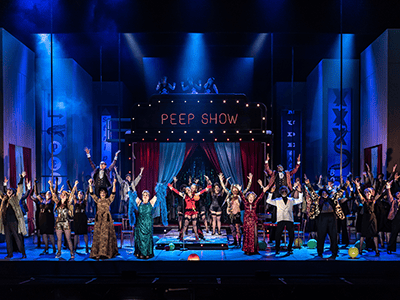ENO Response: Orpheus and Eurydice reviews (Part III)
31st October 2019 in News
ENO Response is a new scheme that gives aspiring journalists and reviewers the opportunity to produce opera reviews and receive writing advice and feedback.
ENO has had no editorial input in the reviews. All views are their own.
Alex Grant-Said
ENO’s Orpheus season has four directors presenting vastly different adaptations of the same well-known myth.
No tale has been so widely portrayed in opera houses over the centuries as that of the mythical musician who overcomes death to rescue his beloved; Jacopo Peri’s 15th Century Eurydice being one of the oldest operatic works in existence.
ENO presents a chocolate box assortment, if camp Offenbach satire doesn’t appeal, you might enjoy conceptual Birtwistle and his electronic synths – and perhaps this is their way of telling apart the praline truffle favourites from the hard toffee sticks.
Wayne McGregor’s adaptation of Gluck’s Orpheus and Eurydice is the official opener to the season, though thankfully I saw Emma Rice’s Orpheus in the Underworld first, which proves a more engaging introduction to the myth. Where Rice has added a lot to her 19th Century source material to bring us an emotional and relevant story, McGregor has just added bodies.
The accomplished Studio Wayne McGregor dancers dish out muscular plies but do little to propel the story forward. With the exception of a few visually striking moments of choreography such as when Orpheus meets a writhing mound of semi-naked Furies pulsating in time with the orchestra, the dance remains seemingly independent from the opera’s narrative and its emotional beats. Considering McGregor praises Gluck’s clean simplicity, his decision to flood the stage with busy choreography is strange.
Alice Coote reprises the Orpheus trouser-role 18 years after her first rendition although the mezzo-soprano’s tone seems a touch strained. In fairness she confessed to fighting a viral infection on opening night and maybe this lingers.
More than her vocals, Coote is let down by movement directions that makes the mezzo appear heavy footed in comparison with her surrounding cast members, particularly jarring when paired against a lithe Jacob O’Connell who acts as her literal body double.
The director’s decision to split his Orpheus and Eurydice in two, with both a singer and ballet dancer assigned to each character could have been an interesting dramatic device, articulating a marriage between soul and body, voice and action. Instead dancer-Orpheus-O’Connell and singer-Orpheus-Coote seem to portray two entirely different beings and the confusing tag-team often means one has to quickly slink to side and wait for the other to take over the action.
Louise Gray’s costumes add to the confusion. Orpheus and Eurydice are dumped into sacks salvaged from Stephen Sprouse’s offcut bin, detracting from the pathos of the tragic couple. There is the merest hint of Grecian toga for the dancers of hell but otherwise they’re left in a mess of tattered Day-Glo rags and the crystalline vocals of Soraya Mafi’s Love are upstaged in Act II when she reappears with an inexplicable, comical cardboard hat.
With Lizzie Clachan’s set design very much suggesting settings rather than showing them outright, abstract video projections come and go, it feels as if the various departments are at odds with one another, presenting their individual concepts on the catwalk without sharing notes.
Music is the true pleasure of the night. Harry Bicket’s conducting has the score emerging triumphantly from the pit even as it fights distracting choreography onstage. Sarah Tynan also elevates the performance, graceful and desperate as Eurydice. Her death knell duet with Coote manages to capture real heartache for the doomed lovers and makes Orpheus’s decision to look back that much more understandable. The chorus, despite being left unseen alongside the orchestra, manage to make their presence known with bold singing. Their traditional place onstage as shades of Hades and Elysium might have served the drama better and put the production’s music, its intrinsic subject matter, on equal footing with the dance. It’s a big and rather bare space for those dancers to fill.
Overall McGregor’s staging struggles to reconcile its various parts, obscuring the dramatic heart of Gluck’s opera with aimless fuss.
Naomi James-Mitchell
Wayne McGregor’s directorial debut in Opera has turned out to be a success. McGregor’s merging of Opera and balletic dance was done well in this reimagining of the Orpheus myth.
The choice of using Berlioz’s version of Gluck’s Baroque opera was ingenious, as the romantic era spin Berlioz added to the music was perfect to add dance to. This more expressive version allowed for many dance sequences to be carried through the opera without losing the meaning of the piece. What I initially thought may hinder the success of this opera was by having only three cast members, however the stunning vocal on all three members carried the show and the stage never felt musically bereft. It was also a good choice on McGregor’s front to have the ENO chorus sing from off stage as this provided no distraction for the audience from the story.
The character Love (Soraya Mafi), was particularly mischievous yet helpful, portraying the intentions of her character beautifully. Mafi also kept up quite decently with the dancers, in terms of movement direction, she never seemed out of place or awkward when doing so. Though, Orpheus (Alice Coote OBE), seemed very uncomfortable and stiff, especially in Acts one and two. That was what made this opera quite unusual, as the second half was better than the first! Coote came into her own in the second half and proved why she deserves her OBE for her services to opera. Coote grew in stage presence and her character intentions as Orpheus were delivered much clearly. Nonetheless, the vocals on Orpheus were beautiful throughout and the emotion conveyed in his ‘What will I do without Eurydice’ aria was heartbreaking. Yet Eurydice (Sarah Tynan), who was decidedly absent from the first half; was astounding in the second. Tynan had magnificent stage presence and such a beautifully resonant voice that perfectly conveyed her character’s emotions seemingly effortlessly. Not only Tynan’s vocal quality great, but also her movement quality; she kept up with the dancers and she never looked out of place or awkward.
Though I’ve found Lizzie Clachan’s set design very interesting and inventive up until now, I must say that I was disappointed at this production’s set. I understand that she was designing for dance so could not design for large trucks to take up the space, however, a dull grey box and a yellow plastic tomb just wasn’t imaginative, and the stage ended up looking quite bare. The lighting designer (Jon Clark) lit the stage appropriately to the goings on happening onstage, but I really felt the lighting really came alive when it was matched to the videos being played on the huge LED board. Video designer (Ben Cullen Williams), made beautiful videos from simple water rippling, to frantic colour blocks fit so well with what was happening onstage. This melded with the lighting mimicking the video helped the whole show seem cohesive and work really well together. I must say that I had my doubts about the costumes, especially when the dancers came on in neon patterned attire in act two, but costume designer (Louise Grey) was just stringing me along! Now I will leave this part as a surprise, but those neon costumes were transformed from being my most hated costume in this production, to my favourite in the space of less than fifteen minutes. My only confusion over costume was the dancer who was dressed in only sin coloured underwear. I didn’t understand how presenting this dancer as naked reflected Orpheus’s character.
The fourteen dancers from Studio Wayne McGregor created scenes on stage that were so dazzling and alluring, it seemed as though they had transported me to another place. The soloists were especially breath-taking, as they held such great stage presence and showed off their great athletic talents. I was particularly impressed with the dancers Sharia Johnson, Rebecca Bassett-Graham, and (in particular) Jacob O’Connell. These dancers caught my eye as I felt they were able to connect and express the story of Orpheus and Eurydice through the choreography of Wayne McGregor. O’Connell was particularly striking, not only for his striking skin coloured costume, but the way he moved was powerful, fascinating and memorable.
Overall, I really liked this interdisciplinary approach to the most traditional opera in the ENO’s Orpheus series. It was done in a subtle yet effective way which only aided to the positive reception of this opera. It surprised me admirable ways and when I was least assuming. This merging was a great success.






